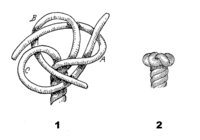Wall and crown knot
| Wall and crown knot | |
|---|---|
 | |
| Names | Wall and crown knot, Manrope knot |
| Category | Decorative |
| Related | Turk's head knot, Underwriter's knot |
| ABoK | 847 |
| Instructions | |

A wall and crown knot is a decorative kind of rope button. The original use of the knot was to put at the end of the ropes on either side of a gangway leading onto a ship.
672. ...the wall and crown knot...was mentioned by Moore in 1801. The wall is tied first, and then a crown is superimposed.
A wall and crown knot consists of a wall knot and a crown knot with doubled strands.[3] A wall knot may be described as an upside down crown knot.[4] The strands of the wall knot go over, under twice, and over, while the strands of the crown knot go under, over twice, and under. In the wall and crown knot they are tied in opposite directions.
670. "Crowning" is mentioned by Steel in 1794. The Vocabulary of Sea Phrases of 1799 gives both the crown and the double crown...To tie a three-strand crown: Hold the apparatus as in the right upper diagram, and tie the knot in a counterclockwise direction. Take one strand, and cross it over the next strand ahead. Take the second strand, cross it over the end of the first-moved strand and across the standing part of the next strand ahead. Take the third strand, and cross it over the end of the strand last moved, then tuck the end through the bight of the next strand ahead (which, in the Three-Strand Knot, is the first strand that was moved). Draw the knot up, and it will appear as in the last two diagrams.— The Ashley Book of Knots[2]
671. The wall knot is the exact reverse of the crown knot. If either of these knots is turned upside down it becomes the other knot. But as the stem of a knot leads from the bottom, the knots ordinarily are different.John Smith mentions the "wall knot" in 1627, Manwayring the "wale knot" in 1644, Blanckley the "whale knott" in 1750, and Falconer the "Walnut" in 1769. Even in Falconer's day standardized spelling and pronunciation had hardly been thought of...To tie a three-strand wall knot: Take one strand and bring it counterclockwise under the next strand. Take the next strand, and pass it under the end of the first-moved strand and under the standing part of the next. Take the third strand under the second end and up through the bight of the first-moved strand.
— The Ashley Book of Knots[2]
This knot is often confused with a Turk's head knot, as both knots have a basket weave pattern.
See also
- List of knots
- Diamond knot
- Eye splice
- Footrope knot
- Triple crown knot
- Matthew Walker knot
References
- ↑ http://www.gutenberg.org/ebooks/13510?msg=welcome_stranger
- 1 2 3 Ashley, Clifford W. (1944). The Ashley Book of Knots, p.116. Doubleday. ISBN 0-385-04025-3.
- ↑ Shaw, George Russell (MCMXXXIII). Knots: Useful & Ornamental, p.50-51. [ISBN unspecified].
- ↑ Williams, Laura and Mann, Elise (2011). 75 Chinese, Celtic & Ornamental Knots, p.66. ISBN 978-0-312-67531-8.
External links
- "Manrope Knot", Marinews.com. Accessed: March 2013.